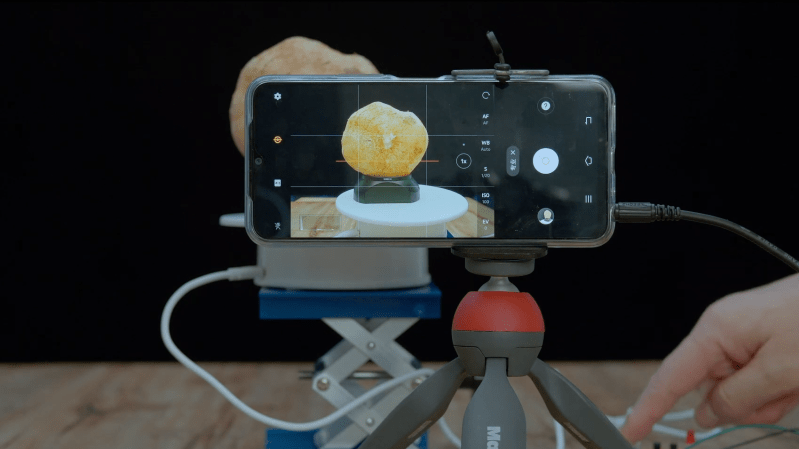Photogrammetry is a great way to produce accurate 3D models of real objects. A turntable is often a common tool used in this work as it helps image an object from all angles. [Peter Lin] wanted a way to run the photogrammetry process with minimal human intervention, and set about building an automated turntable setup.
The build relies on a smartphone to take images of the physical object. The phone is triggered to take photos by an ESP8266, which fires the shutter via the phone’s audio socket. The microcontroller then turns the turntable on for a short period of time after each shot, rotating it by a set angle.
The build still requires objects to be repositioned in various orientations on the turntable now and then, in order to capture the top and bottom areas that would otherwise be obscured. However, the grunt work of taking the photos and rotating the objects is now entirely automated.
It’s a useful build for anyone that finds themselves regularly imaging objects to create 3D models. The results of [Peter]’s rig look great, and as a bonus come with life-like textures ready to go. We’ve seen some other great photogrammetry builds before, too. Video after the break.















Doesn’t the lighting change if you rotate the object, making the photos useless? Or, is this not a problem for photogrammetry software anymore?
maybe he use a setup with difuse light
Not so much useless, but not as good.
There’s a few DIY rigs that address this by mounting the camera to a lazy-susan ring, so the camera moves around the object.
Lighting is important, but if done correctly, it is not an issue. I think the best way to answer this question is to build one and try it, this is something hard to explain
A fixed high-resolution video camera could make the need to coordinate rotation with camera shots unnecessary. Most photogrammetry software already accept videos as input. But this rig is more cool :-)
To some extent, yes. It depends on how much loss the video encoder introduces. I have had some success with using motion-based “recreation” of missing pixels (basically taking frames from after the next full frame to fill in gaps in current frames).
However, my experiments show that you get better results when shooting from a still camera and use 1/4 sized RAW images (not the bull**** JPEGs most phones output). 1/4 sized so you don’t have to interpolate for color, since for meshing you don’t need color and will do a downscale anyway in most algorithms. For color projection vertex color is good enough in most cases, which makes evening out lighting issues (mentioned above) simple and straight forward.
Cool, but it’s easier to do this by taking a regular motorized turntable, gluing plastic nubs at 10-degree increments around the underside edge, and soldering a leaf switch to a $4 shutter-release cable and mounting it on an arm under the table so the rotation of the platter fires the camera.
I actually tried to use a photo detector for line tracing, but the timing is so stable, it really is not necessary to make it more complicated
See kids, there right here, a true engineer! Hats off to you sir.